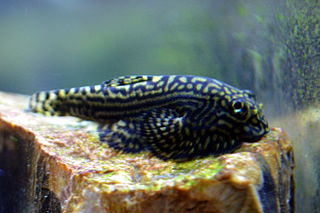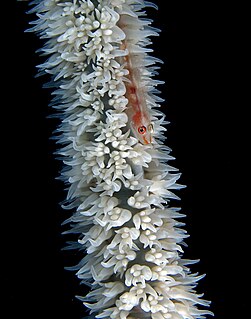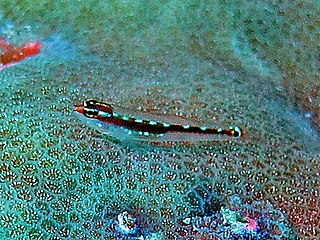
Akysis is the largest genus of catfishes of the family Akysidae.
Pseudobagarius is a genus of catfishes of the family Akysidae.

The racer goby is a species of goby native to fresh, sometimes brackish, waters, of the Black Sea basin. It is a Ponto-Caspian relict species. The species is placed a monotypic genus, Babka, which was once considered a subgenus of genus Neogobius, but was then elevated to genus-status based on the molecular analysis.
Maurice Kottelat is a Swiss ichthyologist specializing in Eurasian freshwater fishes.

Alburnus sarmaticus is a species of ray-finned fish in the genus Alburnus. Widespread in European rivers: Southern Bug, Dnieper, Danube ; River Kolpa, an upper tributary to the River Sava in Croatia and Slovenia. Almost extirpated in Danube, to be probably survived only in River Kolpa.

The tadpole-gobies (Benthophilus), also called pugolovkas, are a genus of Ponto-Caspian fishes in the family Gobiidae.

The stellate tadpole-goby is a species of gobiid fish native to the basin of the Sea of Azov where it occurs in the Gulf of Taganrog and limans of the eastern coast. It also lives in the lower Don River up to the Tsimlyansk Reservoir. It occurs in fresh and brackish waters of depths greater than 3 metres (9.8 ft), preferring shallow coastal lagoons and lowland rivers. Males can reach a length of 13.5 centimetres (5.3 in) TL while females only reach 11 centimetres (4.3 in) TL.

The Black Sea tadpole-goby is a species of goby native to the basin of the Black Sea. Found in the Gulf of Tendra and limans of the north-western Black Sea, lakes of the Danube Delta. In the rivers of the Black Sea basin: Danube up to Iron Gate dam, Dniester up to Tighina, Dnieper up to Kyiv, Southern Bug. This species is mostly a denizen of fresh and slightly brackish bodies of water, preferring rivers and deltas, limans and coastal lakes. This fish can reach a length of 15 centimetres (5.9 in) TL.

The Don tadpole-goby is a species of goby widespread in the basin of the Sea of Azov, specifically in the lower Don River and Tsimlyansk Reservoir. This species is found in rivers, reservoirs and river mouths, but is not known to enter seas. It is introduced and invasive upstream the Volga River, e.g. the Kuibyshev Reservoir. This fish can reach a length of 6.6 centimetres (2.6 in) SL. Life span is about one year.

The Azov tadpole goby is a species of goby native to the basin of the Sea of Azov, specifically in the near-estuary zone of the Kuban River, to west until Ukrainian part of the Taganrog Bay and the Strait of Kerch, in the Mius estuary, Yeya estuary, and Akhtanizovskii Liman. This species is only found on silty estuarine bottoms. It can reach a length of 8.4 centimetres (3.3 in) TL.

The Caspian tadpole goby is a species of goby which is widespread in the basin of the Caspian Sea, specifically in the near-estuary zone of the rivers and in small bays. It is a common species in the Volga River delta near Astrakhan, occurred in the deltas of rivers Terek, Ural, Samur. During the warmer months, this species prefers to live at depths of from .5 to 10 metres, moving in the colder months to depths of 20 to 25 metres. It can reach a length of 11.6 centimetres (4.6 in) TL.

The granular pugolovka is a species of gobiid fish widespread in the Caspian Sea. It is a small fish, with a length up to 5.6 centimetres (2.2 in) TL. It was listed as Least Concern by the IUCN in 2008: there are no known major threats. Granular pugolovkas are very abundant in their habitat due to their size and lack of natural predators. The common name 'pugolovka' is a Ukrainian word for tadpole.

The small-spine tadpole-goby is a species of goby, a small fish native to the eastern coasts of the Caspian Sea and the lower reaches of the Volga River up to Volgograd. In the sea it is recorded from the Cape Peschany to the Çeleken Peninsula and Ogurja Ada Island in the south. It is abundant the Volga River delta. This species can be found at depths down to 50 metres (160 ft) although the adults generally are not found deeper than 11 metres (36 ft). This species can reach a length of 6.6 centimetres (2.6 in) TL. The specific name honours the Azerbaijani ichthyologist A. A. Mahmudbekov, studied the fish of the Caspian Sea for much of his life.

The Caspian stellate tadpole-goby, also known as the starry goby, is a species of gobiid fish endemic to the Caspian Sea basin. It is widespread along all coasts of the Caspian Sea with exception of the central-eastern, and in the lowest part of the Volga River. In the southern part of the basin, it is mentioned near the Ogurja Ada, in the Gorgansky Bay, and in the Sefīd-Rūd River. This species can reach a length of 10 centimetres (3.9 in) SL.

Benthophilus svetovidovi is a species of goby native to the eastern coasts of the Caspian Sea: near the capes Sagandyk, Melovyi, Peschany, Karasyngyr, off Türkmenbaşy, probably near Ogurja Ada.

Sewellia is a genus of fish in the family Balitoridae found in Laos and Vietnam. According to Roberts (1998) a possible defining characteristic of the genus Sewellia is their posterior pelvic valve is highly complex and different from other rheophilic loaches, their posterior pelvic valve involves the overlapping of the second to last ventrally exposed rays. Adapted to high velocity streams Sewellia have depressed body shapes that are laterally expanded thus increasing their hydrodynamical properties and allowing them to better stay attached to rocks in swift current. Sewellia also have paired fins with a single simple ray and numerous branched rays allowing them to grip rocks in swift current.

Bryaninops yongei, the wire-coral goby or whip coral goby, is a benthic species of goby widely distributed from the tropical and subtropical waters of the Indian Ocean to the islands in the center of the Pacific Ocean.
Papuligobius is a genus of fish in the goby subfamily, Gobionellinae, native to Southeast Asia. It was erected in 2003 to house the species P. uniporus, newly described from Laos. A second species, P. ocellatus, was transferred from genus Rhinogobius at the same time.

The giant red tail gourami is a large species of gourami belonging to the family Osphronemidae. It is native to the Southeast Asian island of Borneo, where only known from the Kinabatangan and Segama river basins in Sabah, East Malaysia. First described in 1992 based on an aquarium specimen, its exact range was not entirely certain, leading some source to incorrectly also report it from Indonesia.

Eviota sebreei, common name Sebree's pygmy goby or striped dwarfgoby, is a species of fishes belonging to the family Gobiidae.

















